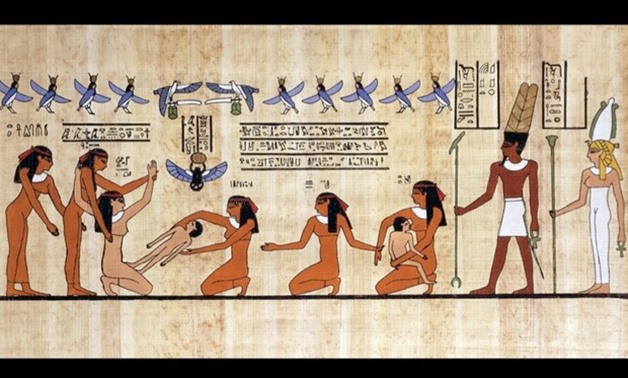
File - Pharaonic mural
CAIRO – 10 August 2018: Ever wondered what people in ancient societies did when they fell ill? A recent study published in History Extra by Caroline Rance discusses a number of interesting historical facts about medicine.
1. Egyptian Females were the First Doctors
Five thousand years ago, about 20 miles south of Cairo at the archaeological site of Saqqara, the area was the ancient Egyptian city of Memphis and is still home to the pyramid of Djoser, one of the oldest buildings in the world.
This area holds the tomb of Ptah. She happens to be the first known doctor by name who lived in 2700 B.C. According to the hieroglyphics on her tomb, she was described as the ‘head of doctors.’ Inevitably, this shows that it was possible for women to occupy important, top-level jobs in Ancient Egypt.
Approximately 200 years later, another female doctor by the name, Peseshet, was named ‘doctor’s supervisor.’ Again indicating that female doctors were widely present and valued as part of the Ancient Egyptian society.
2. Eye Surgery was Possible in 6th Century BC India
One of the oldest books in medical history by Sushruta Samhita, explaining detailed information on medicine, surgery, patient pain management, was written in Sanskrit Indian with no original copy now. Experts say that the book was written in about 600 B.C.
The doctor had a lot of surgical descriptions on how to remove the white water (Cataract). For instance, the patient had to look at the tip of his nose while the doctor used a needle to penetrate the eye. One of the tips she expressed would ensure the operations success is to make sure the patient avoids coughing, sneezing or anything that would cause pressure in the eye.
3. The Tree of Life Treats Scurvy
Jacques Cartier, a French explorer from the 1500s, and his ship crew were once confined to the ice near Stadacona, the current city of Quebec. Since their crews were poorly fed, they suffered exhaustion and weak bones that caused their skin to fall off. These symptoms, known as vitamin C deficiency, are scurvy.
They tried to fight the disease by extracting an Iroquois medicine from the leaves and bark of a local conifer, referred to as Annedda. Although the French wondered if this was part of a conspiracy to poison them, those who took the medication were cured within days. Unfortunately this discovery did not gain popularity and so the disease persisted amongst sailors for almost 200 years.
4. Theriac Treats Everything
Mithridates, also known as the Mithradates of Pontus the 6th, tried to resist toxins by gradually increasing doses because in the past, oftentimes kings were targets of poisoning schemes. He was known to have conducted these toxic experiments on convicted prisoners with a drug that combines an all-in-one strong medicine.
However, when he was eventually defeated by a Pompey military commander in 66 B.C, his pharmacological status reached Rome. A doctor composed 64 ingredients which became known as ‘Theriac,’ including the famous botanical components, opium.
By the 12th century, Venice became the main exporter and the substance was of great importance in European, Arab and Chinese medicine.

Comments
Leave a Comment